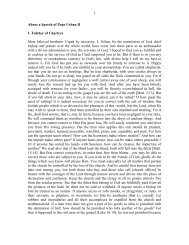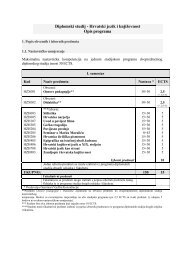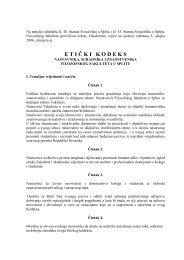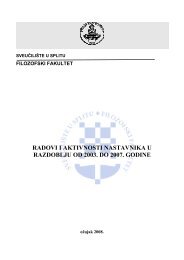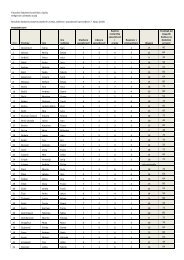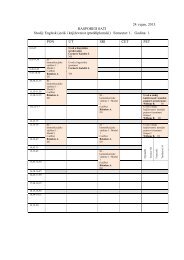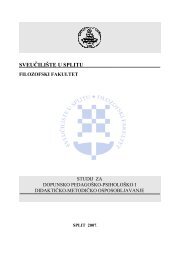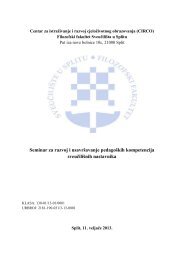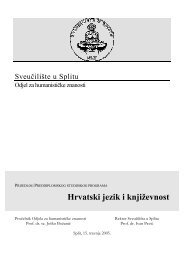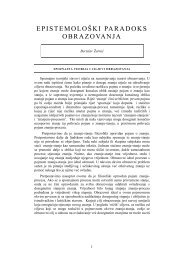English Studies
English Studies
English Studies
You also want an ePaper? Increase the reach of your titles
YUMPU automatically turns print PDFs into web optimized ePapers that Google loves.
G R A D U A T E D E G R E E P R O G R A M M E : E N G L I S H S T U D I E S<br />
Course contents<br />
Recommended<br />
reading<br />
Supplementary<br />
reading<br />
The course explores the space beyond formal and disciplinary boundaries<br />
and the overlap between language and literature. It focuses on literary<br />
interpretation that is substantiated by analysis. This involves precision of<br />
reference to the text in support of a particular reading. Attention to textual<br />
detail heightens awareness of how textual worlds are constructed through<br />
the exploitation of novel possibilities of language. The underlying<br />
assumption is that analysis increases the aesthetic effect of the literary text.<br />
The relationship between literary criticism and stylistic analysis is also<br />
commented on.<br />
After a discussion about the concept of style and the procedures for<br />
interpretation and analysis, the course is structured around three main<br />
literary genres: poetry, prose and drama. The main topics are the<br />
representational use of language and effects of foregrounding in poetry, the<br />
discourse structure of drama and dramatic dialogue, prose style and the<br />
discourse structure of fictional prose. In conclusion, the course addresses<br />
some important questions of literary translation.<br />
Carter, R. and McCarthy, M. (1995). Discourse and creativity: bridging the<br />
gap between language and literature. In Cook, G. and Seidlhofer, B.<br />
(eds), Principle and Practice in Applied Linguistics. Oxford: Oxford<br />
University Press, 303-321.<br />
Verdonk, P. (2002). Stylistics. Oxford: Oxford University Press.<br />
Widdowson, H.G. (1992). Practical Stylistics. Oxford: Oxford University<br />
Press.<br />
Short, M.H. (1996). Exploring the Language of Poems, Plays and Prose.<br />
London: Longman.<br />
Leech, G.N. and Short, M.H. (2007). Style in Fiction (2nd edn.). London:<br />
Longman.<br />
Watson, G. and Zyngier, S. (eds) (2007). Literature and Stylistics for<br />
Language Learners: Theory and Practice. Basingstoke: Palgrave<br />
Macmillan.<br />
Bonačić, M. (2005). The translator’s craft as a cross-cultural discourse. In<br />
Caldas-Coulthard, C.R. and Toolan, M. (eds). The Writer’s Craft, the<br />
Culture’s Technology. Amsterdam: Rodopi, 129-143.<br />
Teacher-generated materials<br />
Black, E. (2006). Pragmatic Stylistics. Edinburgh: Edinburgh University<br />
Press.<br />
Bonačić, M. (1999). Tekst, diskurs, prijevod: o poetici prevođenja. Split:<br />
Književni krug.<br />
Bonačić, M. (2007). Poetic Deviation and Cross-Cultural Cognition. In<br />
Jeffries, L., McIntyre, D., Bousfield, D (eds) Stylistics and Social<br />
Cognition. Amsterdam & New York, NY: Rodopi, 165-179.<br />
Goodman, S. and O’Halloran, K. (eds). (2006). The Art of <strong>English</strong>: Literary<br />
Creativity. Hampshire: Palgrave Macmillan/The Open University.<br />
Hoover, D.L. and Lattig, S. (eds) (2007). Stylistics: Prospect and<br />
Retrospect. Amsterdam: Rodopi.<br />
Lambrou, M. and Stockwell, P. (eds) (2007). Contemporary Stylistics.<br />
40



